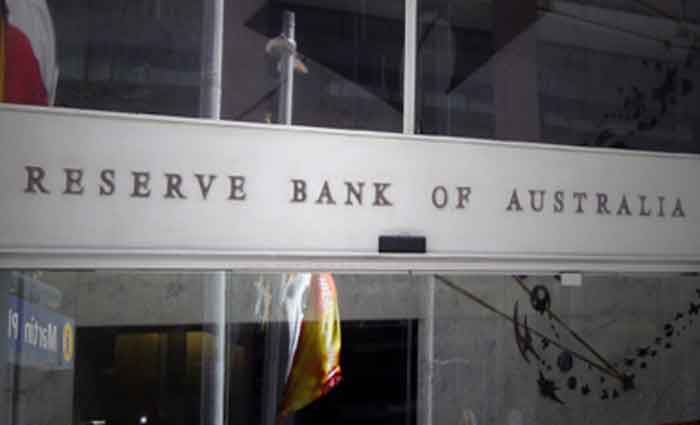How the RBA looks at property, debt and financial stability: RBA's Michele Bullock
GUEST OBSERVATION
This is an edited extract from Michele Bullock's speech to the Urban Development Institute of Australia (WA) in Perth on 20 March 2019.
The wellbeing of households and businesses in Australia depends on growth in the Australian economy. And a crucial facilitator of sustained growth is credit – flows of funds from people who are saving to people who are investing. Credit provides households and businesses with the ability to borrow on the back of future expected income to finance large outlays, for example, the purchase of a home or equipment to establish or grow a business. A strong and stable financial system is important for this flow of funds.
There is no universal definition of financial stability but one way to think about it is to consider what is meant by financial instability. My colleague Luci Ellis suggested that this is best thought of as a disruption in the financial sector so severe that it materially harms the real economy. This leaves unsaid where the disruption might come from, but we would all recognise the outcomes of financial stability when we see it. For example, while Australia was spared the worst impact of the global financial crisis, internationally it demonstrated the impact that financial instability can have on growth and hence the wellbeing of households and businesses in the economy.
Most of you will know about the Reserve Bank's role in conducting monetary policy. But another key role of the Reserve Bank that you might be less familiar with is promoting financial stability. In this area, we share responsibility with the Australian Prudential Regulation Authority (APRA). But it is APRA that has responsibility for the stability of individual financial institutions and the tools that go along with that. So how does the Bank contribute to financial stability?
There are a number of things we do. We undertake analysis of the economy and the financial system through the lens of financial stability, looking for financial vulnerabilities that could result in substantial negative impacts on the economy, or economic vulnerabilities that could result in risks to financial stability. We work with other regulators to identify signs of increasing risks in the financial system and measures to address these risks. Where appropriate, we provide advice to government on the potential implications for financial stability of policies. And we talk about the risks we are seeing to help inform other regulators, participants in the financial system, businesses and the general public of the potential risks that might have an impact on the economy.
This last action – communicating the risks – is the key purpose of our six-monthly Financial Stability Review (the Review). While any individual financial institution, business or household might think the risks they are taking on are appropriate, they may not be adequately taking into account the risks that are arising at a systemic level from everyone's actions. The Review attempts to bring this system-wide view.
Our most recent Review was published in October last year and we are currently in the process of drafting the next one, which will come out in April. So, for the remainder of my talk, I am going to cover some of the key risks that we see at the moment. Given the audience, I am going to focus on risks related to residential and commercial property. First, I will give an update on recent developments in these areas. Then I will talk a little about recent concerns around tighter lending standards. And I will finish up with a few observations on the property market in Western Australia.
Household Debt
Six months ago in the Review, we noted that global economic and financial conditions were generally positive and that the Australian economy was improving. At the same time, housing prices were declining. In this context, we highlighted a number of vulnerabilities – issues that, were a shock to occur or economic conditions take a turn for the worse, could manifest in a threat to financial stability. At that time, we highlighted two domestic vulnerabilities that are relevant to my talk today – the level of household debt, and the slowdown in housing and credit markets. Six months on, these vulnerabilities remain. If anything, they are a little more heightened.
The Bank has highlighted the issue of household debt as a potential threat to financial stability many times over the past few years. Although it does not capture all the important information about household indebtedness, the ratio of household debt to disposable income is one summary indicator. This ratio is historically high (Graph 1). The household debt-to-income ratio rose from around 70% at the beginning of the 1990s to around 160% at the time of the GFC. The ratio steadied for a few years before starting to rise again around 2013 (around the same time that housing price growth began to accelerate) and is now around 190%.
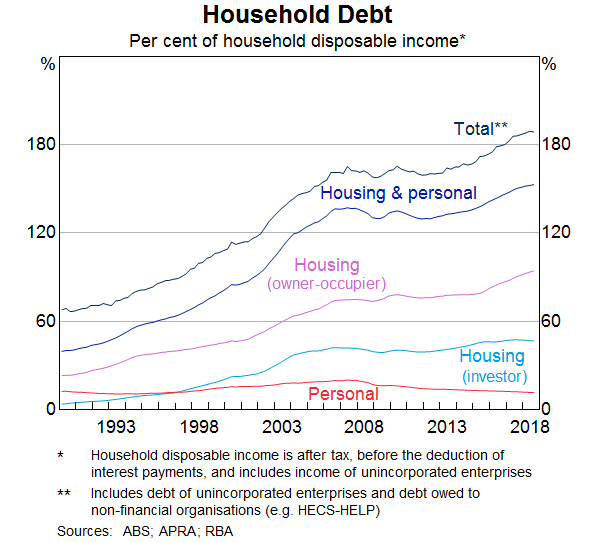
I have talked previously about some of the reasons why the debt-to-income ratio has risen so much over the past few decades. In particular, a structural decline in the level of nominal interest rates and deregulation have eased credit constraints and increased loan serviceability. And as households have been able to borrow more, they have been able to pay more for housing. One important driver of high household debt in Australia is, therefore, housing. There is very little debt related to non-housing loans such as credit cards or car loans.
Just as housing costs have been an important driver of household debt, so has the ability to borrow more influenced the price of housing. Over the past decade, housing prices in many parts of Australia have risen but the rise has been particularly sharp in Sydney and Melbourne, which account for around 40% of the housing stock (Graph 2). More recently, housing prices have fallen. Since the peak in mid 2017, housing prices Australia-wide have declined by around 7%. The falls in Sydney and Melbourne have been larger. The question we are asking ourselves is, given the high levels of debt and falling housing prices, are there any significant implications for financial stability?
Graph 2
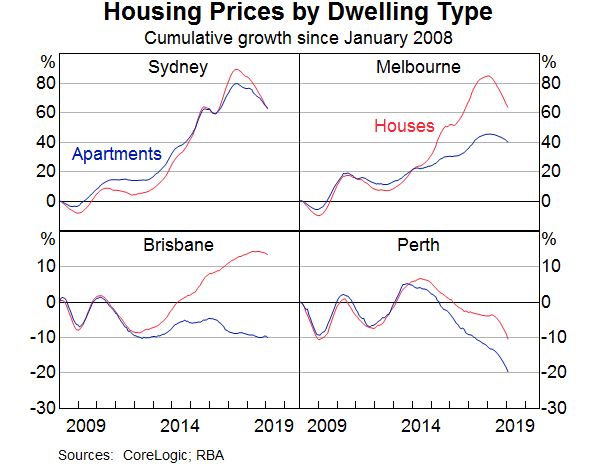
The answer would be no at this stage – the impacts are not large enough to result in widespread problems in the financial sector. This is not to downplay the financial stress that some households are experiencing. But most of the debt remains well secured against property, even with the decline in housing prices. Total repayments as a share of income remain steady and a large number of indebted households have built up substantial prepayments over the past few years. Broadly, the debt is held by households that can afford to service it. Arrears rates, while increasing a bit over the past few years, remain low. Banks are well capitalised and work over recent years to improve lending standards has made household and bank balance sheets more resilient. Loans at high loan-to-valuation (LVR) ratios and interest-only loans are less common than they were and most households have not been borrowing the maximum amount available.
Apartment Development
One area that we have focused on in recent years in our analysis of financial stability risks is apartment development. There has been a substantial increase in apartment construction since the start of the decade in the largest Australian capital cities (Graph 3). In Sydney there have been more than 80,000 apartments completed over the past few years adding roughly 5% to housing stock in Sydney. Melbourne and Brisbane have also seen relatively large additions to the supply of apartments and, while the number of apartments being built in Perth has been small by comparison, this has been in the context of a fairly small apartment stock.
Graph 3
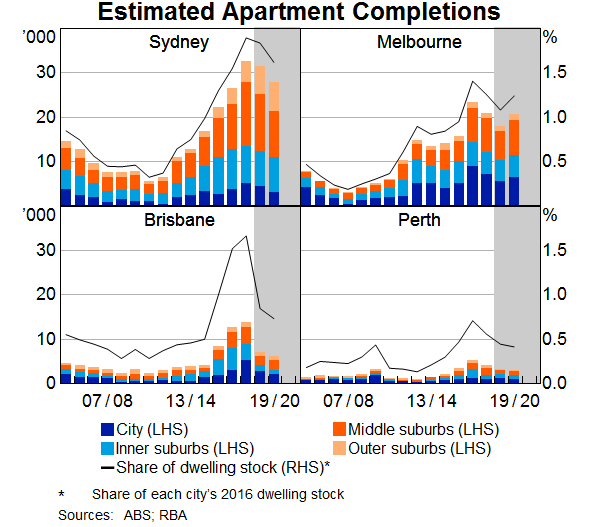
Our main concern with this from a financial stability perspective is the potential for this large influx of supply to exacerbate declines in housing prices and so adversely impact households' and developers' financial positions. By its nature, high-density development can tend to exacerbate price cycles. Large apartment developments have longer planning and development processes than detached housing. Purchasing the land, designing the development, getting approvals through relevant government bodies and then actual construction of the apartment block all take time. In a climate of rapidly rising prices, developers are willing to pay high prices for land on which to build apartments. Households, including investors, are willing to purchase apartments off the plan, confident that the apartment will be worth more than they paid for it when it is finally completed. This continues as long as prices are rising. This large increase in supply, however, ultimately sows the seeds of a decline in prices which, if large enough, results in development becoming unattractive, new supply falling and the cycle starting again.
This presents two risks. The first is to household balance sheets. A decline in apartment prices could negatively impact households that purchased off the plan and are yet to settle. They might find themselves in a situation where the value of the apartment in the current environment is less than they contracted to pay for it. And as market pricing falls, lenders will revise their valuations down and so will be willing to lend less. Households will therefore have to contribute more funds, either from their own savings or loans from other sources.
The second risk is to developers who are delivering completed apartments into the cooling market. If people who had pre-purchased are having difficulty getting finance, or decide it is not worth going ahead with the purchase, there would be increasing settlement failures. Developers would be left holding completed apartments, reducing their cash flow and their ability to service their loans, and impacting banks' balance sheets.
Currently, the risks here appear to be elevated but contained. The apartment market is quite soft in Sydney; apartment prices have declined since their peak, rental vacancies have risen and rents are falling (Graph 4). In Melbourne and Brisbane, however, apartment prices have so far held up. Liaison suggests that settlement failures have not increased much and, to the extent that they have, some developers are in a position where they can choose to hold and rent unsold apartments. Further tightening in lending standards might, however, impact both purchasers of new apartments and developers – I will return to this in a minute.
Graph 4
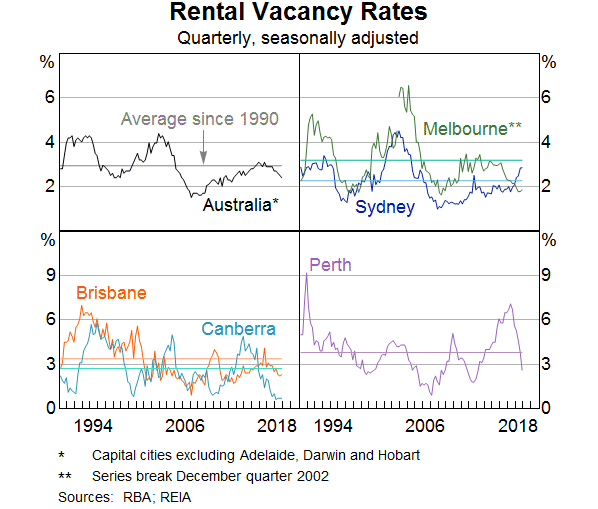
Commercial Property
A final area worth touching on is non-residential commercial property.
Commercial property valuations have, like housing, risen substantially over the past decade, and much more than rents so that yields on commercial property have fallen to very low levels historically (Graph 5). This is particularly the case for office and industrial property. One reason for this is that yields, although they have been historically low in Australia, are high relative to overseas and to returns on other assets. Furthermore, some markets, such as the Sydney and Melbourne office property markets, are experiencing strong tenant demand and vacancy rates are low. But the rapid increase in commercial property prices over the past decade does pose risks. If transaction prices and valuations were to fall sharply, for example, in response to a change in risk preferences, highly leveraged borrowers could be vulnerable to breaching their LVR covenants on bank debt. This could trigger property sales and further price falls, exacerbating the cycle.
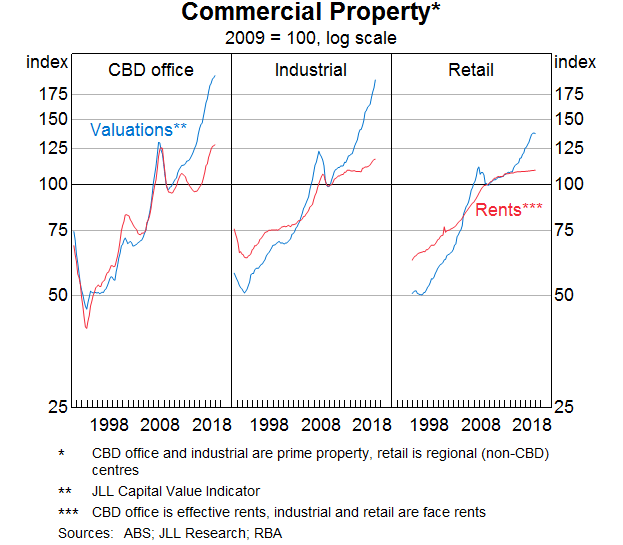
Lending Standards
With that background, I want to turn to an issue that has attracted a fair bit of attention in recent months – the role that tightening lending standards might have played in the downturn in credit and the housing market. We published a special chapter in the October 2018 Reviewon this issue and the Deputy Governor discussed it in a speech in November last year so I will only cover it briefly here.
Lending standards have been tightening since late 2014, well before housing prices in the eastern states started to turn down. The initial tightening occurred in December 2014 in response to very fast growth in lending to housing investors and an assessment by APRA that banks' lending practices could be improved. APRA required banks to tighten their lending practices in a number of areas, including interest rate buffers, verification of borrower income and expenses, and high LVR lending. The measure that got the most attention at that time, however, was the ‘investor lending benchmark’ in which APRA indicated that supervisors would be paying particular attention to any institutions with annual investor credit growth exceeding 10%. The idea was that it would be temporary while APRA worked with the banks on addressing lending standards.
The benchmark and the tightening of standards didn't have an immediate impact on the pace of investor lending. It didn't really start to bite until the middle of 2015 when banks introduced higher interest rates for loans to investors. And at that point, growth in lending to investors slowed sharply (Graph 6).
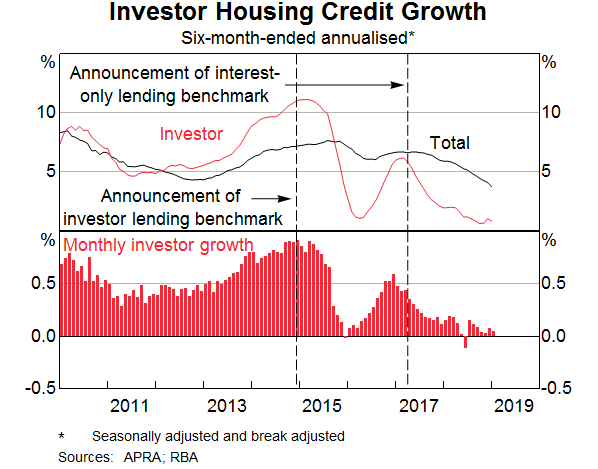
Once things settled down, however, and banks were comfortable that they were well below the benchmark, the growth in lending to investors started to pick up again. Then, in March 2017, APRA introduced restrictions on the share of new interest-only lending as part of its broader suite of measures to strengthen lending practices. As part of this, APRA reinforced its investor benchmark. While the interest-only measure was focused on reducing the volume of higher-risk lending rather than lending to a particular type of borrower, there was a noticeable impact on the growth in lending to housing investors since interest-only loans tend to be the product of choice for many investors.
Both the investor lending benchmark and the interest-only lending benchmark have been removed for banks that have provided assurances on their lending policies and practices to APRA. But the improvements in lending practices implemented by the banks over the past few years have resulted in credit conditions being tighter than they were a few years ago. Application processes have been taking a bit longer as lenders are being more diligent about verifying borrower income and expenses, borrowers are generally being offered smaller maximum loans and some borrowers are finding it more difficult to obtain a loan. Banks are more closely adhering to their lending policies, resulting in fewer exceptions being granted and there are fewer high LVR and interest-only loans being approved.
There have been some concerns expressed that these developments have been a key reason for the slowing in credit growth over the past year. Coupled with possibly some increased risk aversion of front-line lending staff in the wake of the Royal Commission into Misconduct in the Banking, Superannuation and Financial Services Industry, the concern is that this has been impacting housing credit growth and, by extension, housing prices. As concluded in the Banks' February Statement on Monetary Policy, and noted by the Governor in a recent speech, tighter credit conditions do not appear to be the main reason for declining housing credit growth. The evidence points towards declining demand for housing credit as being a more important factor.
Nevertheless, it is possible that tighter lending standards could be impacting developers of apartments. This could be direct, reflecting banks' desire to reduce their exposure to the property market, particularly high-density development. But it could also be indirect by banks tightening their lending standards for purchases of new apartments, hence impacting pre-sales for developers and their ability to obtain finance. The Deputy Governor noted this in a speech in November 2018 and concluded that this was of potentially higher risk to the economy than household lending standards.
From a financial stability perspective, prudent lending standards are a good thing. They ensure that households and banks are resilient to changes in circumstances. But there needs to be a balance. The regulators are not proposing any further tightening in lending standards. And the appropriate amount of credit risk is not zero – banks need to continue to lend and that will inevitably involve some credit losses.
Western Australia
Finally, I want to turn my focus to developments in Western Australia. As you will have seen from some of my earlier graphs, the Western Australian circumstances are somewhat different to those of the eastern capital cities. There are two aspects I would like to focus on – household resilience and the commercial property sector.
Housing prices in Perth have been declining for some years (Graph 7). The peak in housing prices in Perth was in the middle of 2014. This followed a period of strong housing price growth as the population of Western Australia increased strongly during the mining investment boom and housing construction took longer to ramp up. When housing construction did respond, however, population growth had slowed markedly and housing prices started to fall. Median housing prices have fallen by around 12% since 2014.
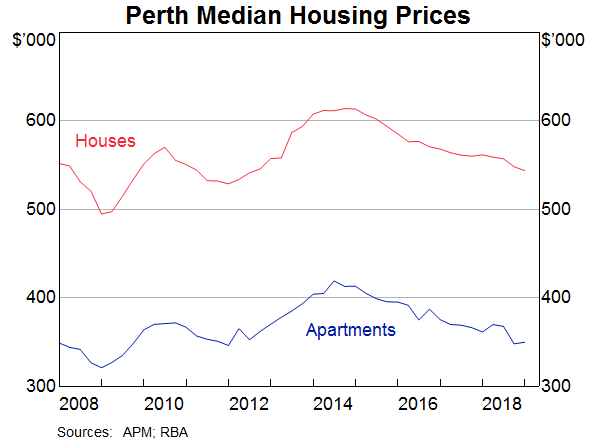
This has clearly been a difficult time for many homeowners in Western Australia. There are some households that are having difficulty meeting repayments, as evidenced by a rising arrears rate in Western Australia (Graph 8). At this stage, however, the losses are not large enough to threaten the stability of the financial sector. We nevertheless continue to monitor the situation for any potential systemic impacts.
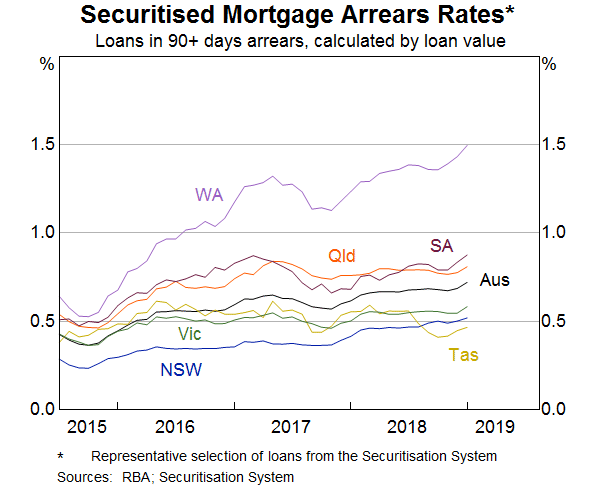
Finally, office property in Western Australia has also been experiencing oversupply. Valuations have fallen over the past decade (Graph 9). Rents have also fallen reflecting a sharp increase in office vacancy rates in Perth's CBD over the past few years (Graph 10). This makes for a challenging environment for owners of these buildings, particularly for owners of older or lower quality office buildings as tenants have taken the opportunity to move into newer buildings as rents have come down. But again, while a difficult time for developers and owners of office buildings, the financial stability implications seem limited.
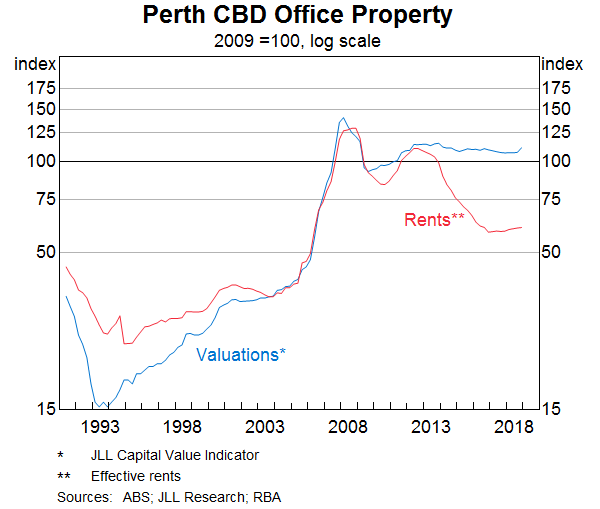
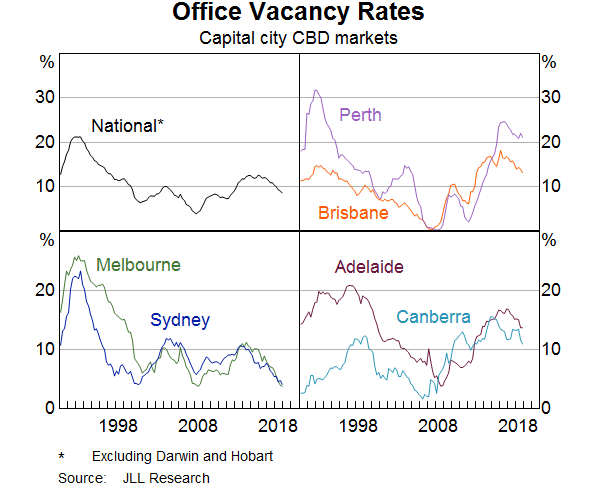
Conclusion
Vulnerabilities from the level of household debt, the apartment development cycle and the level of non-residential commercial property valuations continue to present risks for financial stability. While so far, the financial sector has remained resilient, we continue to monitor developments in household debt and in property markets for signs that these might have more broad ranging effects on the financial system.
Michele Bullock is Assistant Governor (Financial System) at the Reserve Bank of Australia (RBA).
